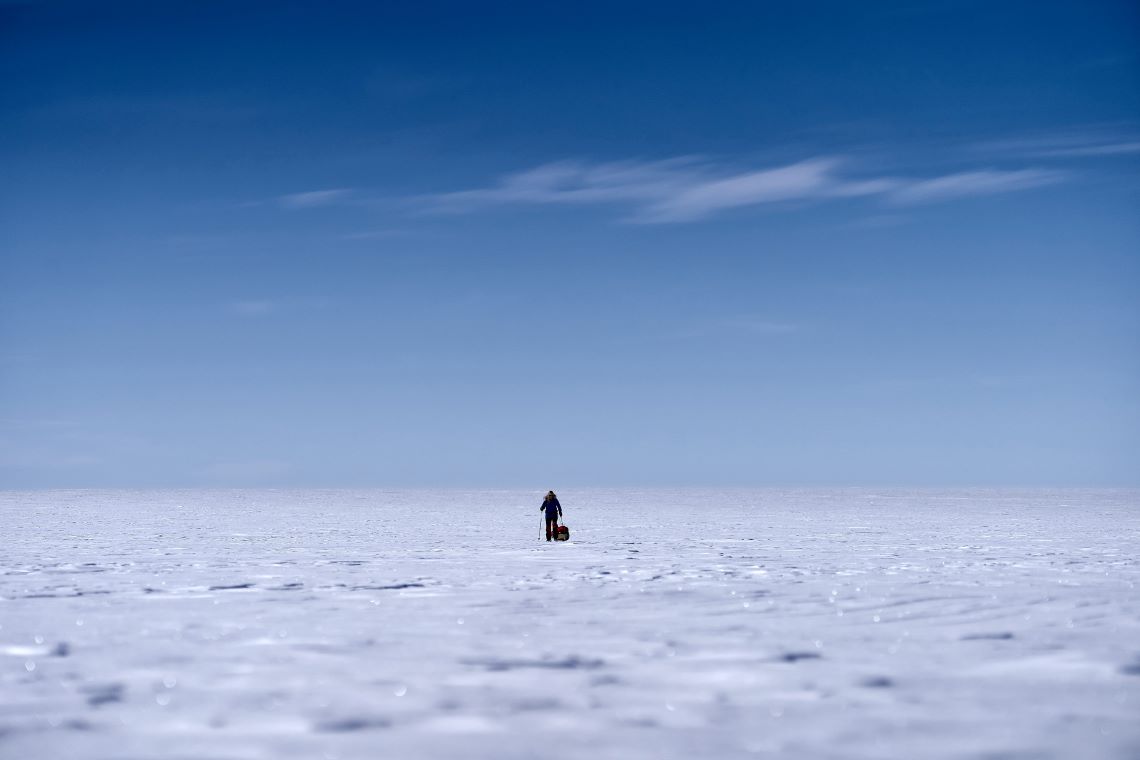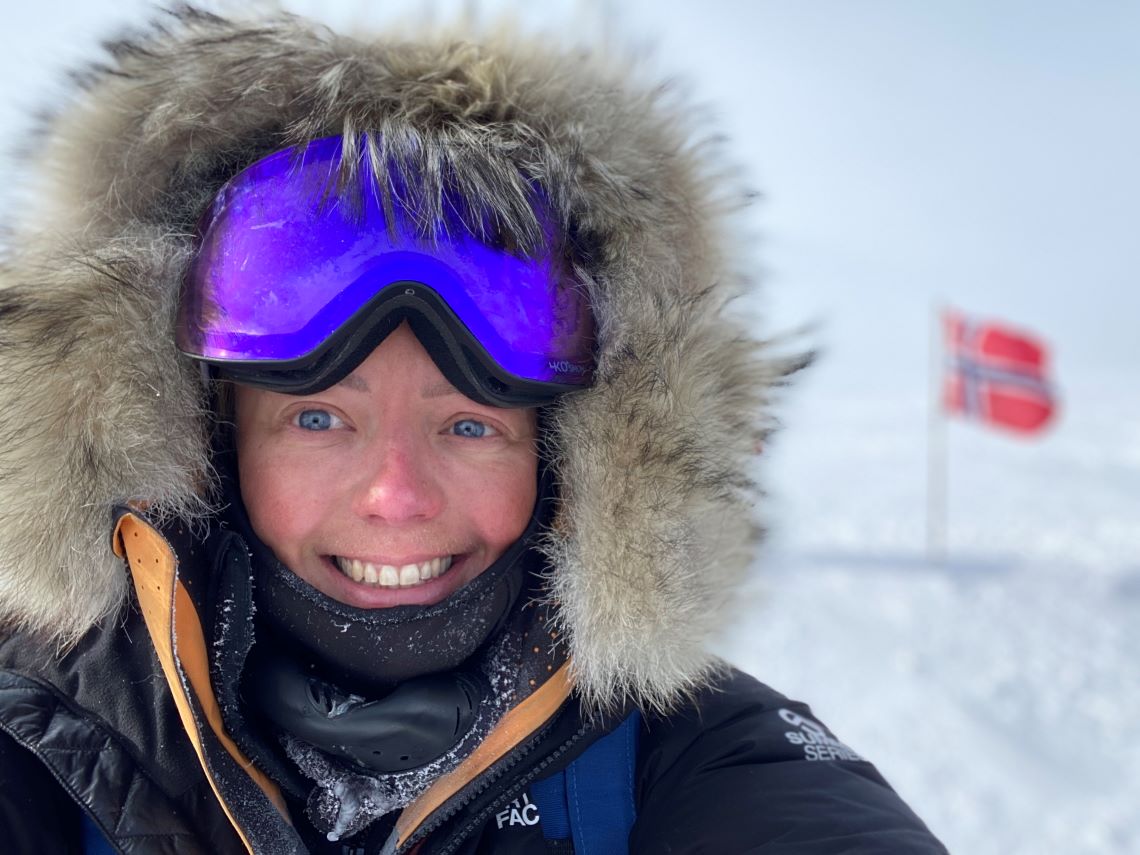Jenny Davis: Pole Position
At the end of 2019, JENNY DAVIS went to ANTARCTICA in a second attempt to set the world record for the fastest SOLO journey to the SOUTH POLE. A bad fall left her almost unable to walk, dashing all hopes of breaking the record, but Jenny wasn’t giving up. Here, she tells AMABEL BUCK about her incredible journey…
The next time anyone tells me I run ‘like a girl’, I’ll smile and point them in the direction of Jenny Davis, a British lawyer turned professional athlete who travels the globe in search of some of the world’s most extreme races and expeditions. You could say she was born into a life of adventure. Growing up on the island of Balikpapan, Borneo, young Jenny was blessed with an abundance of exciting landscapes to conquer and explore. “We moved there when I was four or five,” she recalls. “I spent my childhood running around the rainforest with my brothers. It was an amazing place to live. Growing up there definitely made me want to do outdoors stuff”.
With adventure in her blood, it’s hardly surprising that taking on challenges like running the 2015 Marathon des Sables soon led to a love of expeditions. “I’ve been fascinated by Antarctica, the history of it, and Shackleton’s expedition since I was a teenager, and always wanted to do something over there,” she says. Her initial plans to take a ski team down Mount Vinson (one of the seven summits) and on to the Pole was thwarted due to the £500,000 price-tag of obtaining satellite imaging over the area. Not easily discouraged, Jenny formed a new plan. “I guess because I put the expedition together, I’d read all my old books again, I was like, ‘Oh my gosh, I know what I’m going to do! That trip can’t happen, so I’m going to go for the speed record to the Pole.’ And it kind of happened from there.”
The current women’s speed record for ski trekking to the South Pole is held by Swedish explorer Johanna Davidsson, who made the 750-mile journey from Hercules Inlet to The Pole in 38 days, 23 hours, and five minutes in 2016. “When I first attempted [to break the record] in 2018 it was the worst weather they’d had in 50 years or something ridiculous,” Jenny recalls. The appalling conditions during Jenny’s first expedition were the least of her worries, though; on day 21 of her trek to the Pole she was medivacked out of Antarctica due to a life-threatening bowel infection.
“I definitely didn’t want to be medivacked, but it was the right thing. Peritonitis is a very dangerous illness because you get septicaemia quite quickly,” she explains. “A polar explorer two years before had died from the same condition.” In true Jenny style, however, she flew back to the UK and was already plotting her return to the South Pole before being discharged from hospital.
Forewarned is forearmed and a year later, Jenny was preparing for her second attempt at the Antarctic speed record. “I put on a lot more muscle this time,” she says. “But what I mostly learnt from that first attempt was that I could definitely do it. I’d obviously never been to Antarctica before then. [This time] it was more; yes, I can actually do this, I just need a chance to go back. What I love about being solo is that you’re responsible for every single little thing; you can’t rely on anyone else. It’s a little bit scary, but it’s so empowering.”
Her second chance came at the end of 2019 when once again Jenny found herself facing the gruelling solo trek across the frozen tundra. “I remember when the plane dropped me off, I didn’t know if I would cry or burst out laughing, because I’d been dreaming about it for so long. And then I got the giggles. It was such a beautiful day and I just stood there, laughing for a good 10 minutes, I couldn’t believe where I was.”
“It’s 24-hour sunlight in Antarctica at that time of year as it’s their summer. When it’s blue skies and sunny, its actually really lovely,” she smiles. “On a good-weather day, [trekking] is definitely more straightforward. But that’s the whole thing in Antarctica: you’re always on this edge. It’s one of the most hostile environments in the world and it can just suddenly turn. You don’t want to get too excited about a great-weather day because the next day you could be in a -50C windstorm.”
Jenny’s previous bad-weather experience paid off on her second attempt, however. “There were a couple of storms where I got weather warnings to not travel in them, but I’d travelled in so much worse the year before, I just thought it was a joke,” she laughs. The real trick, though, is to just keep going. “In bad weather, I never want to stop. Your hands start to get cold, and then you’ve got the pain of starting up again,” she explains “You need breaks every 90 minutes or so to eat some food and get some water in you. The problems happen when you stop eating, you get cold very quickly. My breaks would be no more than four minutes, maybe three, and then you’ve got to start skiing again.”

THE SCIENCE OF SURVIVAL
Clothing also plays an important role in tackling the extreme conditions, of course. “You need to know your gear inside out. It’s about good layering, and you can never sweat,” she insists. “You’re skiing 14-16 hours a day and it gets up to -60C. If you sweat and it freezes then you’re going to get hypothermia pretty quickly.” The expedition was a chance to put The North Face’s FutureLight range to the test. “I just couldn’t believe how light it was!” Jenny exclaims. “I had a moment where I thought ‘I don’t actually trust that this is going to be enough where I’m going!’, but I had a week skiing in Antarctica before I started and [the kit] was amazing.”
Besides the clothes on her back, Jenny had to pull all her provisions and gear herself. “I started with all the food I would need for the whole trip – a mix of dehydrated meals and a lot of Atkins protein bars.” The sled weighed around 65kg when fully loaded and the Antarctic workout is relentless: “I think [I need] about 4,500-5,000 calories per day and you’re probably burning about 10,000 or 11,000 calories per day,” she explains. “I put on about a stone and a half before I left. They did [a body] scan after two weeks of me being home and I’d lost 11 percent body fat, which is quite a lot, but I’d gained 4kg of muscle.”
The physical side of trekking Antarctica is only half the battle, though. With so much time alone, you need mental fortitude, too. “I definitely had a few weird moments, confesses Jenny. “I thought I heard a dog barking while skiing one day. I’ve Googled it and it’s a common thing for people in extreme environments to report. Or seeing things in the distance. You’ll be convinced there’s a tent or something and there’s just nothing there.” Being utterly alone in a frozen wilderness may not appeal to everyone, but for Jenny, it’s one of her favourite places. “It’s a kind of meditation. It’s very peaceful,” she muses.
With better weather and a more informed outlook, Jenny’s 2019 expedition got off to a promising start. “For the first 500 miles I was on pace to break the world record, which was awesome. I felt like I was flying,” she recalls. “Everything was going right. The weather was great too; a couple of storms but nothing major.”
Good weather does little to counter bad luck, however. Just 200 miles from the Pole, an unfortunate fall in sastrugi and a nasty skin tear marked the beginning of the end for Jenny’s record-setting dream. “Imagine a really wild sea and it just freezes so the big waves are suddenly frozen, and you’ve got to ski through it, that’s what [sastrugi fields] look like,” explains Jenny. “They’re very slippery and I had a fall in one of those one day. The whole inside of my leg that had just been a group of ulcers before, split into one big wound and I just lay there, crying my eyes out. It was the most painful thing that has ever happened to me”
Despite her injury and the risk of infection associated with it, Jenny was determined to battle through the pain and make it to the Pole “It’s a huge deal to be able to go to Antarctica and put this kind of expedition together, not once, but twice. I never thought I’d be going back. My sponsors had just been incredible, and for me, personally, I did not want to come back to the UK having failed two years in a row to make the Pole,” she insists.
“I could live with not getting the record, but not with not reaching the Pole for the second time. It was, no matter what, head down, get on with it,” she says. “No matter how much you train and how good the weather is, a lot of it comes down to just luck. And I think that’s what draws me to places like that. It can be going just great and then a couple of minutes later; disaster.”
THE LAST LEG
Besides the pain, Jenny had to fight against the advice of her medical team who recommended she return home. “Every evening we’d do a satellite phone call with the team at base camp in Antarctica. Twice the doctors got on the phone and tried to medivac me because of the leg. And every time I’d politely say, ‘Nope. I’m not being medivacked – I’m not ill, just in a lot of pain.’ One of the things about being an endurance athlete is that you get pretty good at putting pain somewhere else. Truthfully, I didn’t think I was causing that much damage to my leg.”
The damage, as it turns out, was substantial and Jenny underwent two operations and a skin graft to mend the leg, which developed a condition known as Polar Thigh, a friction-like burn that swiftly turns to blisters and then open wounds when left untreated. Jenny’s injury is currently the most severe case of Polar Thigh on record. “That day when I arrived at the Pole, I had skied about 18 hours to get there in one go,” she recalls. “I wasn’t in tears when I made it; I wasn’t jumping up and down with excitement. I didn’t really feel anything if I’m honest. I couldn’t really think about the Pole because my legs were in so much pain.”
Having realised her goal of making it to the South Pole, there was only one way for Jenny to celebrate. “There’s a very small camp and the head guide was waiting there for me. It was about one in the morning and I just collapsed on top of him. We sat down for about two hours having a beer and chatting,” she says. Probably the most well-deserved beer since Captain Anson stumbled into Alexandria.
Jenny may not have taken the record in Antarctica (her time was 44 days), but she certainly didn’t leave empty handed. “The really nice thing for me since coming back is there isn’t any part of me that is gutted about not getting the record; I’m just over the moon that I made it. And that’s a big shift in my character,” she admits. “The first time I went out I can remember saying to my husband ‘If I don’t come back with the record, I’ll be gutted’ that meant everything. And I think now, having completed it with that leg injury, the record doesn’t matter at all to me.”

LOOKING FORWARD
The experience has changed her outlook in other ways, too. “I think I have way more respect for my body now,” she says. “While I was in the hospital, I had these crazy flashbacks where the entire hospital room became a storm in Antarctica and each dream someone different would be preventing me from getting to the Pole. They brought in this psychologist who said, ‘you were so hellbent on making the pole your brain hasn’t processed yet that you’ve done it’. I had a lot of flashbacks to the first shower after peeling off the dressing [on my leg]
too. It was like a mild form of PTSD. Now I’m like, ‘respect your body just a little bit more’. While I might have the ability to push through painful, difficult things, I shouldn’t always do it.”
After all that, it really does beg the question: why would anyone want to put themselves through it? “I really don’t know!” laughs Jenny. “It’s just the way I am. I love being outside, going to new places and seeing what my body is capable of.”
In Jenny’s case, recuperation seems to lead to inspiration, so what’s next on her adventure to-do list? “I’m looking into ocean rowing,” she enthuses. “I quite like the idea of getting involved in something I know nothing about – that really appeals. I’ve never done anything at sea and I’m a bit nervous, I have a bit of a fear around the sea, so it appeals for that reason as well.” Her sponsorship with The North Face has also opened a lot of doors for fulfilling her adventure ambitions. “The last couple of years I’ve been funding things myself, running around, begging for money. It will be really nice to have a more solid foundation!” she laughs “[The North Face] loves sponsoring and being involved in women doing these kinds of things, which is awesome.”
Reaching the South Pole is arguably an outstanding achievement, but perhaps even more so is Jenny’s relentless optimism and her tenacity to realise her goals no matter what. Her advice on making your own dream happen? “Find a mentor. Find someone who’s done something similar and nine times out of 10 they’ll be more than willing to help you out or put you in the right direction. There’s a quote by a famous Scottish mountaineer that’s my all-time favourite. It’s about how everything conspires to help you, but you have to get it out there, you have to give it a shot of actually happening.”
‘Concerning all acts of initiative or creation, there is one elementary truth… that the moment one definitely commits oneself, then Providence moves, too.’
Thank you, William H. Murray, we couldn’t have said it better ourselves.

Photos: Jenny Davis



